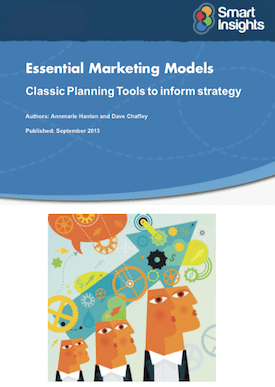Using The Ansoff Matrix to identify growth opportunities
What is the Ansoff Matrix?
This model is essential for strategic marketing planning where it can be applied to look at opportunities to grow revenue for a business through developing new products and services or “tapping into” new markets. So it’s sometimes known as the ‘Product-Market Matrix’ instead of the ‘Ansoff Matrix’. This focus on growth means that it’s one of the most widely used marketing models. It is used to evaluate opportunities for companies to increase their sales through showing alternative combinations for new markets (i.e. customer segments and geographical locations) against products and services offering four strategies as shown.
How to use the Ansoff Matrix
Strategic questions that can be answered using the matrix include:
- Market Penetration: How to sell more of your existing products or services to your existing customer base?
- Market Development: How to enter new markets?
- Product and Development: How to develop existing products or services.
- Diversification: How to move into new markets with new products or services, increase your sales with your existing customer base as well as acquisition.
You may be executing more than one of these strategies depending on the stage in your business,
My best practice tip is to use Ansoff at least once a year in strategic planning for your business to identify potential new markets, new products as well as product development opportunities.
To evaluate the suitability of these strategies, issues to consider for each of these:
- Market Penetration: change your opening hours of your store, reduce order processing times, showcase entire product portfolio etc.
- Market Development: Does your research on your market share in your existing sectors back up potential demand for you to ? Can your company support this with existing resources?
- Product and Development: cheaper manufacturers, improve quality, review packaging, ask customers and influencers for feedback etc.
- Diversification: Assess expertise, technical know-how. Can you move into a new market with a new product offer using the skills in your business? Do you have a strong management team to support it.
Examples of how the Ansoff Matrix can be applied to digital marketing strategy
The Ansoff matrix is useful for developing online strategies too, for example…
- For Market Development strategy. RS Components a supplier of a range of MRO (maintenance, repair and operations) items, found a new online market when they launcher their site, with 10% of their web-based sales to individual consumers rather than traditional business customers. It also uses the website to offer additional facilities for customers placing large orders online.The UK retailer Argos found the opposite was true with 10% of website sales being from businesses when their traditional market was consumer-based. EasyJet also has a section of its website to serve business customers.
- Product development: – e.g. online trade magazine Construction Weekly diversified to a B2B portal Construction Plus which had new revenue streams. Similarly, music and book publishing companies have found new ways to deliver products through a new development and usage model such as subscription and pay-per-use. Retailers can extend their product range and provide new bundling options online also.
- Diversification: Ryanair offers it customers discounts if they book car hire with Hertz car rentals.
To find out more how to review these strategies, read our free Models Guide which explains how to use the strategies for some of the following objectives.
- 1. Market Penetration: market share growth, customer loyalty improvement and customer value improvement.
- 2. Market Development: use of online channels to sell into new markets at low cost. Sell existing products to new market segments and different types of customers.
- 3. Product development: Use the web to add value to or extend existing products or services.
- 4. Diversification: into related business, unrelated business, upstream integration with suppliers, downstream integration with intermediaries.
What to watch for?
Fairly new business then perhaps it’s wise to focus on no more than two strategies, which could be Market Penetration and over time move to Market Development.
The Original Reference Source
Ansoff, H. I. (1957). Strategies for Diversification. Harvard Business Review. (Vol. 35 Issue 5, Sep/Oct). p113-124.

